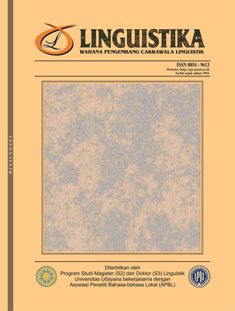SUBSTITUSI ANTARKONJUNGSI BAHASA JEPANG DALAM NOVEL GUROTESUKU
Abstract
This study aims to find out the inter-functional substitution of Japanese in a discourse. The data used in this study are written data taken from the discourse of the novel entitled Gurotesuku by Natsuo Kirino. In general, the research method used is a qualitative method. Data collection is done by referring and recording techniques. Meanwhile, informal methods are used in presenting the results of data analysis. The theory of cohesion and coherence proposed by Halliday and Hasan (1976) and Halliday (2014) with a structural approach used as theory in this study is supported by Makino and Tsutsui (1989 & 1995). Based on the results of the study, it is known that inter-functional substitution occurs in internal substitution and external substitution. The Japanese inter-functional substitution found in Gurotesuku's novel is junsetsu no setsuzokushi 'conjunction cause-effect relationship' which consists of genin to riyuu 'cause and effect conjunctions' and jouken 'conjunction requirements', gyakusetsu no setsuzokushi 'conflict conjunctions', iikae to reiji setsuzokushi no 'parafrasa conjunction', heiretsu to ruika no setsuzokushi 'equivalent relationship conjunction', sentaku no setsuzokushi 'choice conjunction', and hosoku no setsuzokushi 'additional conjunction'. In this study, the data shows that there is only one inter-conjunction external substitution of Japanese, namely heiretsu to ruika no setsuzokushi ‘equivalent relationship conjunction’ with sentaku no setsuzokushi ‘choice conjunction’.













